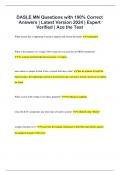Exam (elaborations)
NCCC NUR 211 Test 1 Questions with complete solutions latest 2024/2025( A+ GRADED 100% VERIFIED).
- Course
- NUR 211
- Institution
- Excelsior College
NCCC NUR 211 Test 1 Questions with complete solutions latest 2024/2025( A+ GRADED 100% VERIFIED).
[Show more]












